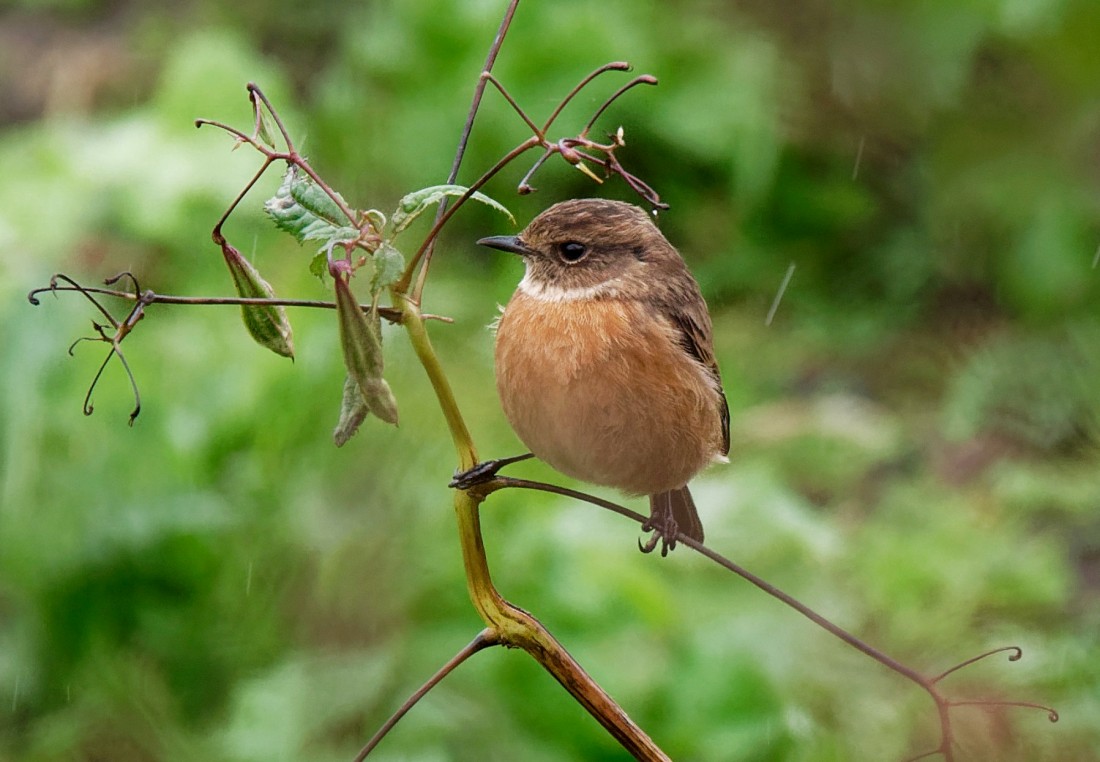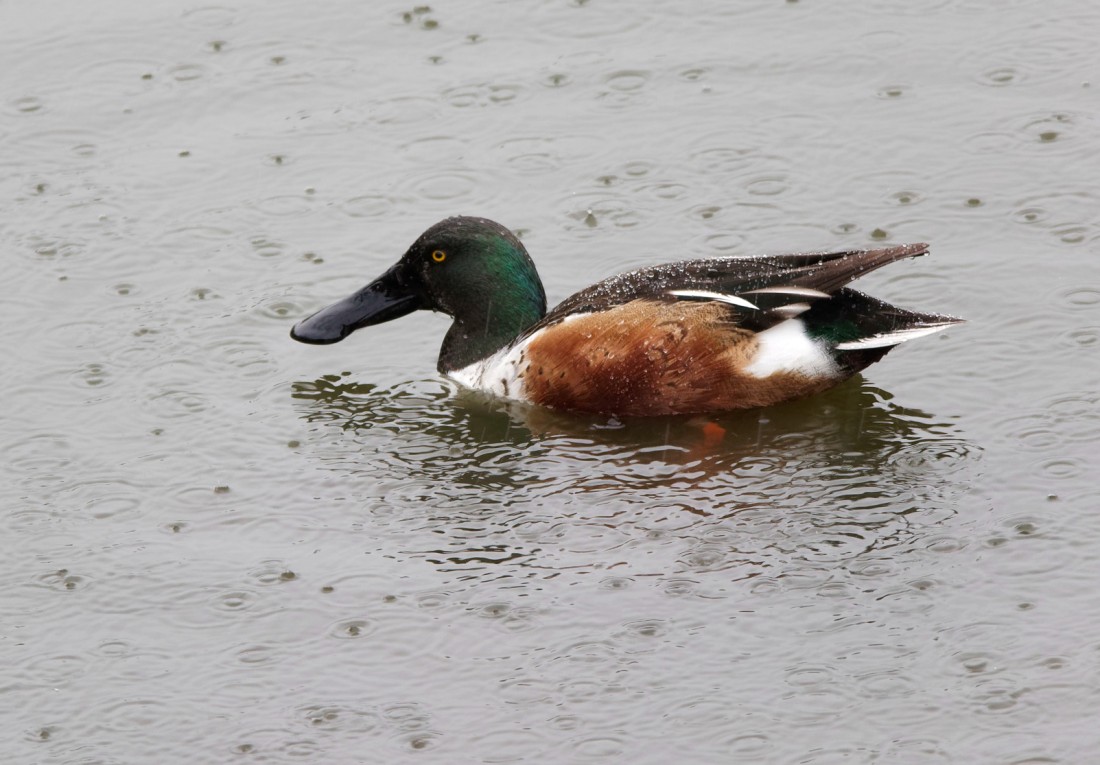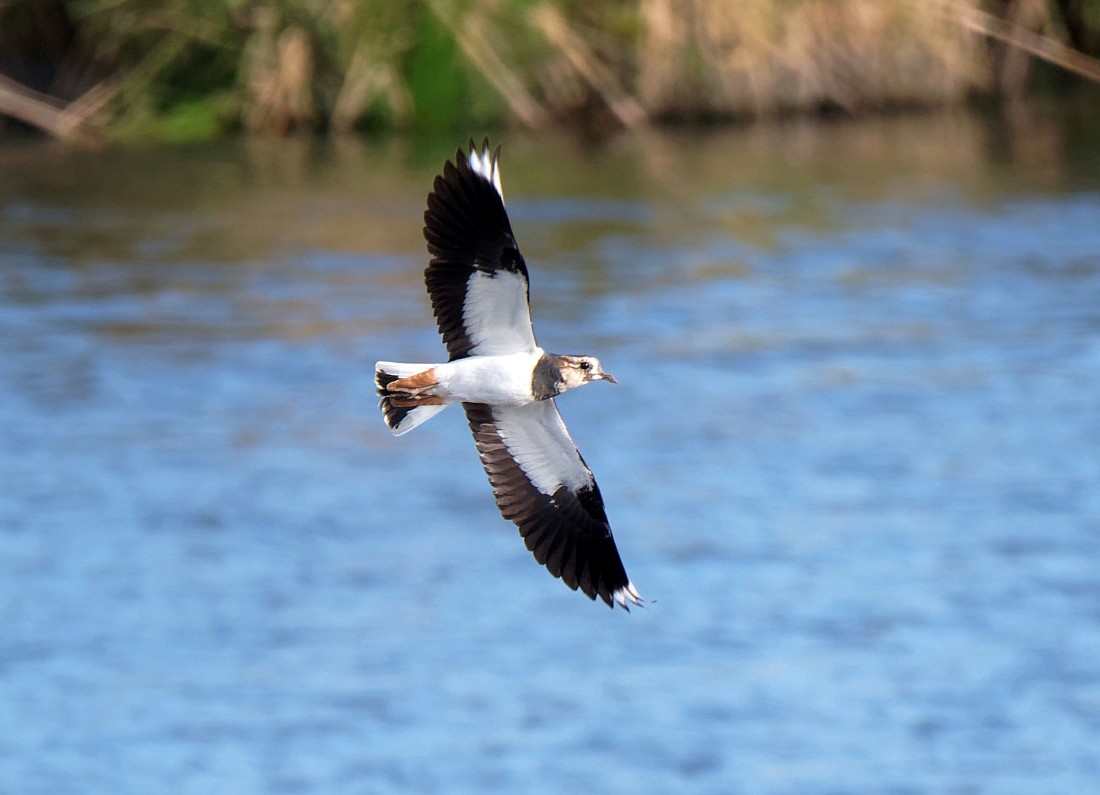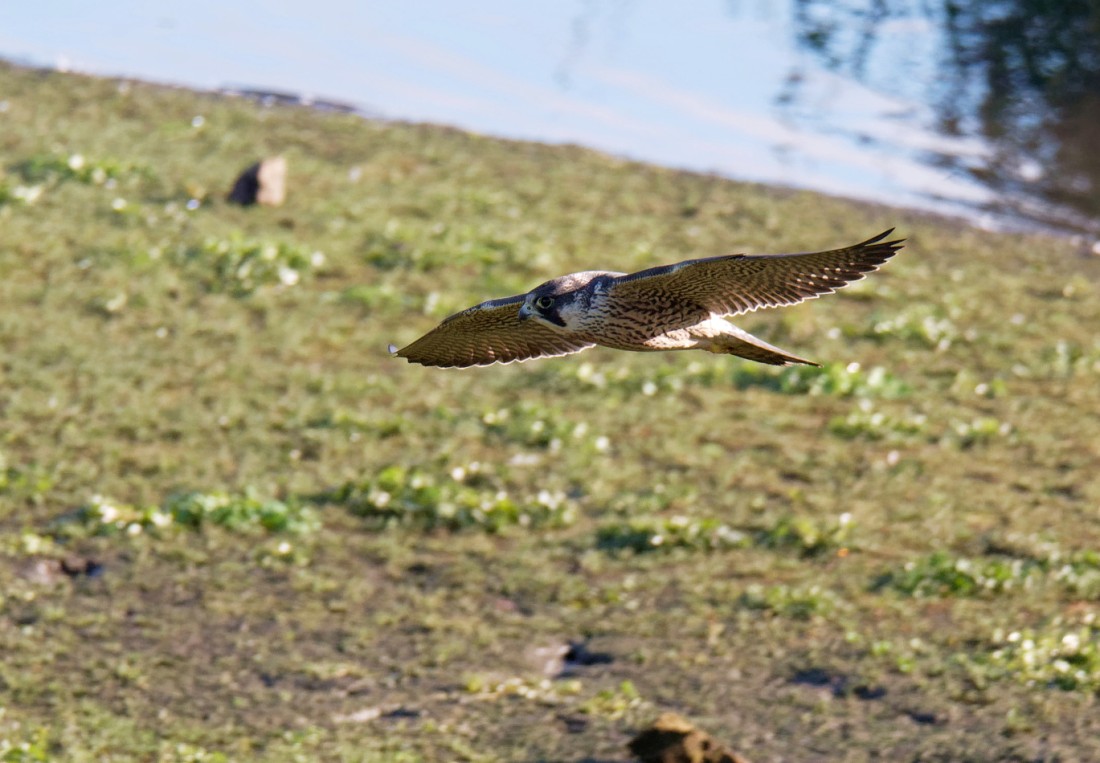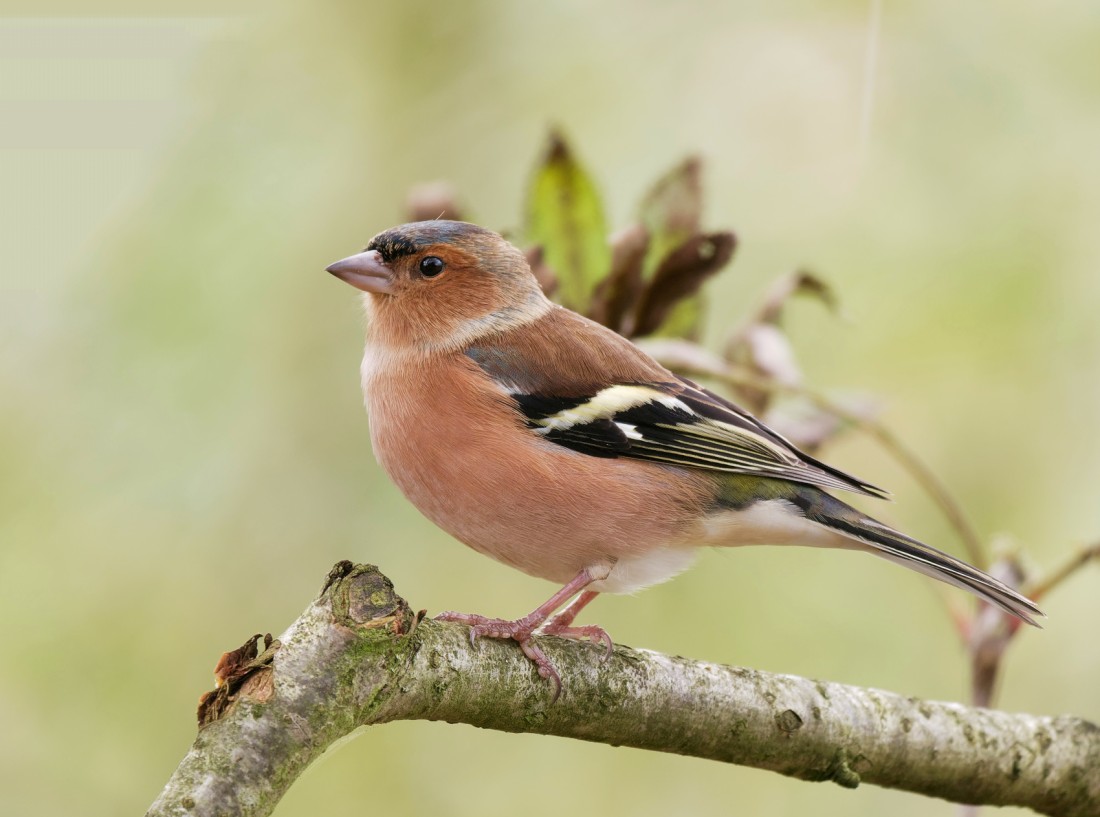Woolston Eyes Monthly Sightings
2020-10-31
Starting at dawn on No.3 bed, there was a noticeable south-easterly passage of woodpigeons, with 870 counted in the first three hours, along with 60 Fieldfares and 20 Redwings. Out on the water, over 1,000 wildfowl were present, including: 3 Wigeon, 1 Shelduck, 78 Tufted Ducks, 450 Teal, 120 Shovelers, 15 Mallards, 90 Greylag Geese and 265 Canada Geese. Other sightings of interest included; a Stonechat, a hunting Peregrine, 3 Sparrowhawks, a Kestrel and 5 Buzzards. As ever, Cetti’s Warblers and Water Rails were calling, though, for once, we managed to see neither. It was also interesting to watch the resident Moorhen which has learned to catch, wash and eat large yellow slugs, doing its stuff again in front of the hide. Photo of the Stonechat Cheers David Bowman (with David Spencer, Helen Wynn and Alan Warford)
Submitted by: David Bowman
2020-10-29
With the prospect of persistent rain this morning at Woolston Eyes, I started with a dawn walk onto No.4 bed to check on progress with the wetland development. Despite the very wet October the work on No.4 bed is progressing steadily and the part which has been completed is holding plenty of water. Birds have been quick to take advantage of this and included: 1 Green Sandpiper, 5 Common Snipe, 4 Wigeon, 220 Canada Geese and smaller numbers of Teal, Mallard, Gadwall and Shoveler. On the seed-rich islands and bunds seed-eaters included: 75 Linnets, 40 Goldfinches, 20 Chaffinches plus a few Skylarks and Meadow Pipits. Later from the Morgan Hide 175 Teal, 2 Wigeon, 2 Water Rails, 14 Moorhens and 1 Kingfisher were noted. Photo of a Shoveler Cheers David Bowman
Submitted by: David Bowman
2020-10-27
A couple of hundred Starlings left a roost at dawn, followed by 400 Woodpigeons before a nice thrush movement started. Small groups of 110 Redwings were first, followed by three Fieldfare flocks totalling 250. A walk round the bed produced more feeding Redwings and Fieldfares, along with 50 Blackbirds and 13 Song Thrushes, some of which were also likely to be continental migrants. Other sightings of note included a Stonechat, a Pink-footed Goose and 4 Wigeon, all on the Morgan Hide scrape. Photo of a passing Redwing Cheers David Bowman (with David Spencer)
Submitted by: David Bowman
2020-10-20
Clear skies and a light SSE wind at Woolston Eyes in October always promise to bring good visible migration. From dawn till 12.00 pm I counted the passage from the Morgan Hide and found some nice surprises, including: 86 Fieldfares and 325 Redwings. 3 late Swallows were also good to see. Finches were represented, too, with small numbers of Bramblings, Siskins and Lesser Redpolls passing over or dropping in, along with a few Meadow Pipits and Skylarks. Most pleasing was the flock of 85 Golden Plovers which passed over mixed in with 1,100 Lapwings. After the count was over I wandered onto No.4 bed, where a three Jack Snipes were with the more numerous Common Snipe and a few more Redwings were feeding. Photo of a Lapwing Cheers David Bowman
Submitted by: David Bowman
2020-10-19
Wildfowl (WeBS) Count 17/10/20 Little Grebe 11, Great crested Grebe 5, Cormorant 15, Heron 5 Mute Swan 35, Greylag Goose 28 Canada Goose 70, Shelduck 1, Gadwall 93, Teal 315, Mallard 198, Shoveler 81, Tufted Duck 161, Water Rail 2,Moorhen 45, Coot 39, Kingfisher 2,Lapwing 1, Snipe 1, Black-headed Gull 59,Common Gull 1, Lesser Black-backed Gull 1, Great Black backed Gull 1. A total of 1170 birds of 23 Species
Submitted by: Brian Martin
2020-10-15
With blue skies and with a light but cool northerly breeze, it looked good for migration on No.3 bed at Woolston Eyes, though in the end a couple of close encounters with our resident predators provided the day’s highlights. Redwings were moving from the start, with around 100 counted by the end of the morning. From the Morgan Hide, Goosander and Pintail were good records for the bed. Then a juvenile male Peregrine came in at high speed, heading straight for the hide. Twice recently I’ve seen this male try to grab a Moorhen from the scrape and narrowly fail. This time it managed to snatch one, landed on the scrape and was in the process of dispatching it when a Buzzard and a Sparrowhawk arrived to mob the falcon. Leaving its prey, the Peregrine vigorously drove the rival raptors away but when it came back, to both our surprise, the Moorhen was gone . The last hour was spent sitting on the steps of the hide, looking west for a raptor watching session. Highlight of this was a small passage of 14 Common Buzzards, tracking south-east at height, something I’ve only seen here once before. Photo of the Peregrine Cheers David
Submitted by: David Bowman
2020-10-13
Not long after dawn the long-staying female Marsh Harrier rose out of its roost, did a couple of circuits of No.3 bed and then headed off towards No.4 bed, no doubt to harass the masses of feeding wildfowl which have adopted the new wetland. The undoubted highlight was the steady movement of migrant thrushes. A walk round the bed produced 5 Fieldfares and 85 Redwings, fresh in from their Scandinavian breeding grounds and feeding on the fruit-laden Hawthorns. On No.4 bed, 40 more Redwings were feeding. The recently raised water level in the new wetland restricted me in terms of how much of an incursion I could make but it was pleasing to find 2 Jack Snipe, a very scarce bird on the Reserve, along with 7 Common Snipe. Then, to finish, a female Merlin came skimming across the bed, flushing flocks of Meadow Pipits, Linnets and Goldfinches. Photo of a Grey Heron Cheers David
Submitted by: David Bowman
2020-10-08
Drizzle at dawn slowly morphed into warm sunshine with not much moving but great views of some of our scarcer resident species. Starting on No.3 bed, no less than six different Water Rails showed well from the various hides, while two Kingfishers and a Cetti’s Warbler were active in front of the Morgan Hide. The undoubted highlight of the morning came when 350 Teal streamed in from the west, almost certainly disturbed from the new No.4 bed wetland. I was just mulling over whether they’d been disturbed by our contractor’s machinery or by the female Marsh Harrier which has been around for the best part of a month, when the harrier suddenly appeared right in front of the Morgan Hide window. She is a very distinctively marked second-calendar year female and I was lucky to grab a few close-range photos before she drifted away across the bed. Photo of the Marsh Harrier Cheers David Bowman
Submitted by: David Bowman
2020-10-06
A rewarding morning at Woolston Eyes, managing to add another species to the 243 we’ve managed to record so far. In front of the Morgan Hide, 2 Kingfishers and 2 Water Rails were the main focus until I noticed 2 small egrets flying west along the north bank of the bed in a light drizzle. I just assumed they were Little Egrets but they didn’t look quite right. Paying more attention I saw the compact shape and unmistakeable profile of Cattle Egrets before they disappeared from view. Whereas Little Egrets are now very common, particularly coastally in the north-west, Cattle Egrets are only just becoming established in much smaller numbers and have been expected at Woolston for a while now. Then it was off to No.4 bed during a break in the rain, hopeful of reconnecting with the egrets. No such luck but good to see the new wetland holding plenty of birds, including: 5 Swallows, 30 House Martins, 15 Snipe, 100 Mallards, 25 Meadow Pipits, 15 Linnet and, 40 Goldfinches, while 4 Ravens passed over. Finishing back on No.3 bed, 500 Teal were milling around, probably disturbed from No.4 bed by our contractor, who was using a digger to clear some areas of Willow re-growth in the wetland. Photo of a Chaffinch Cheers David Bowman
Submitted by: David Bowman
2020-10-05
This link is to a short video shows some of the birds on No.3 bed over the past few days. It includes: Grey Wagtail, Jay, Wigeon, Shoveler, Green Sandpiper, Snipe, Water Rail and Great White Egret.
To watch David’s video click here…… or copy this link into your browser https://youtu.be/_a8AEStp9Zs
Cheers David
Submitted by: David Bowman
2020-10-01
On No.3 bed the Morgan Hide delivered good views of some of our more charismatic birds, including a Green Sandpiper, 2 Water Rails, 2 Kingfishers and 4 Snipe. From the Hogg Hide, another three Water Rails and a couple of Willow Tits showed well. After the recent dry weather I was able, with care (!), to walk the whole of the No.4 bed wetland where 320 Teal, 110 Mallard and 24 Gadwall, 2 Green Sandpipers, 5 Snipe and 10 Reed Buntings were flushed. Back on No.3 bed an elegant Great White Egret strode out of the reeds. Once a real rarity in the UK the population has started to grow steadily, with a few pairs now breeding and we expect to see a few on the Reserve every year. Photo of the Great White Egret Cheers David
Submitted by: David Bowman

